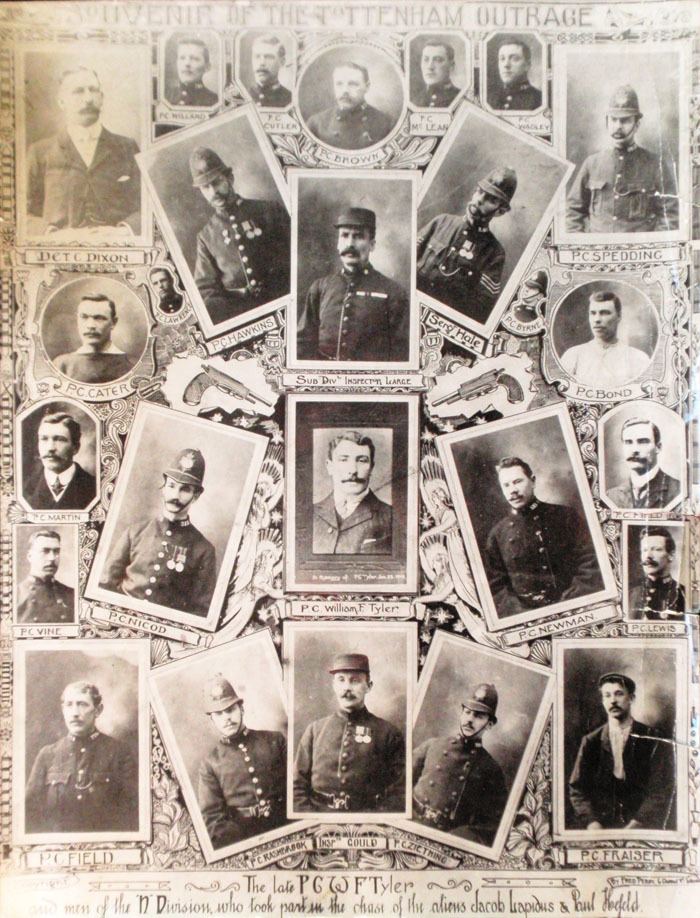 | ||
The black museum the tottenham outrage central tv 1988
The Tottenham Outrage is the name given to an armed robbery and double murder which took place in Tottenham, Middlesex, and Walthamstow, Essex, on 23 January 1909. It was perpetrated by two Anarchists, Paul Helfeld and Jacob Lepidus (sometimes spelled Lapidus), both Jewish immigrants from the Russian Empire. Both anarchists later committed suicide.
Contents
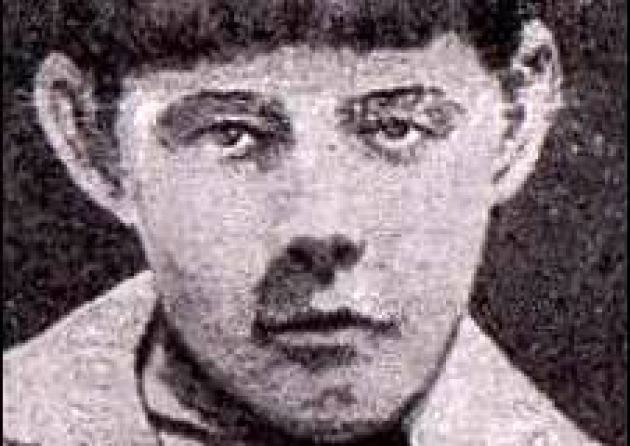
The Tottenham Outrage became a cause célèbre in Edwardian London, with the route of the funeral cortège of the policeman murdered in this act being lined by a crowd of half a million people. The event led to the creation of the King's Police Medal, to reward the gallantry of the police officers involved. It also reinforced a feeling of xenophobia, a fear of immigrants, and further reinforced anti-Semitic views which would be further inflamed by the 1911 Sidney Street Siege.
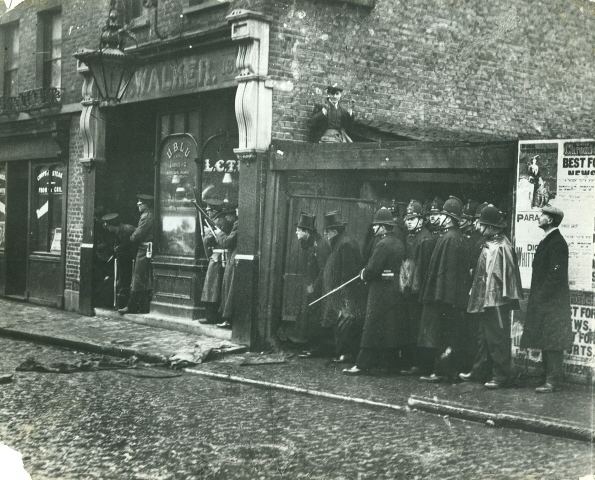
Robbery and chase
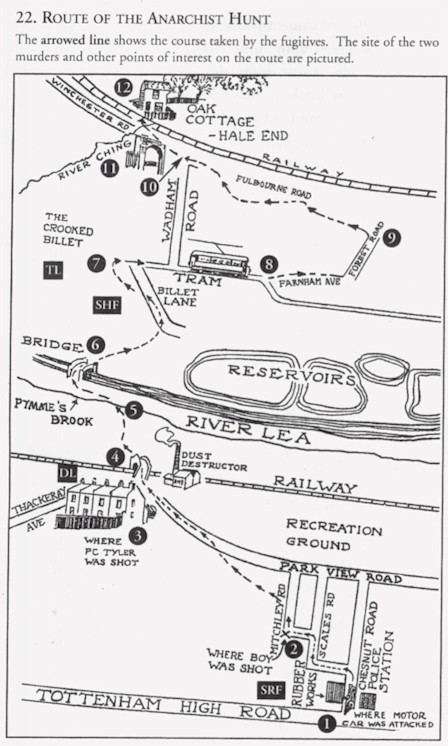
Before the robbery, Helfeld worked at the Schnurmann Rubber Factory in Chesnut Road, Tottenham, for a short period of time. While working there, Helfeld observed that the weekly collection of wages occurred every Saturday morning. Each week, the wages clerk, Albert Keyworth, aged 17, was taken in the factory owner's car by Joseph Wilson to a bank in South Hackney to collect about £80 in gold, silver and copper.

At 10:30 a.m. on Saturday 23 January 1909, Helfeld and Lepidus, respectively armed with FN M1900 and Bergmann 1894 semiautomatic pistols, waited on either side of the entrance to the factory awaiting the car holding the wages. Keyworth left the car and while proceeding to the factory was seized by Lepidus, who tried to snatch the bag, and during the following struggle they both ended up on the ground, whereupon Joseph Wilson joined the fight and restrained Lepidus.
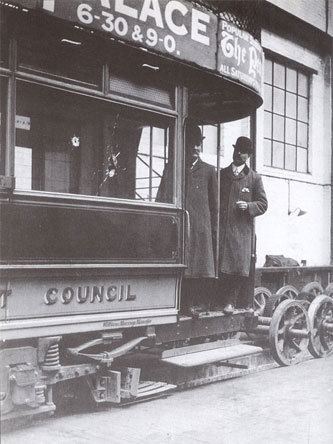
At this point, Helfeld fired several shots at Wilson which all hit him, but due to his heavy layers of clothing caused no injury and failed to penetrate. Upon Lepidus regaining his upright position, he fired once at Keyworth but the shot missed. Two police officers, Constables Tyler and Newman, heard the shots from the nearby Tottenham Police Station and ran to the location of the noise, finding George Smith, a local gas stoker, beating Lepidus while on the ground. Smith was shot twice by Helfeld, in the head and in the collar bone, but survived.
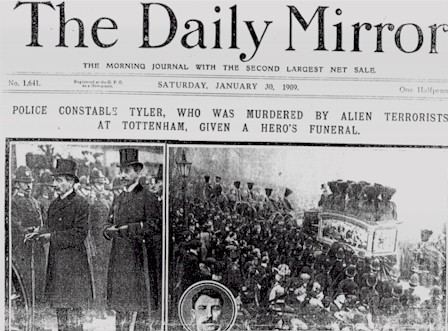
The two gunmen ran from the scene down Chesnut Road, pursued by Tyler on foot and Newman with Wilson in his motor car. By this time, two other constables, Bond and Fraser, had been alerted to the situation and joined the chase, along with a number of other officers. The fugitives, while running, turned and shot at a number of people pursuing them before running through Scales Road into Mitchley Road, where Helfeld stopped to reload his firearm. The car containing Wilson and Constable Newman sped towards Helfeld and Lepidus trying to run them over, attracting a hail of bullets from the two men. The car crashed, causing both those inside injury. Inadvertently caught up in the hail of bullets, a 10-year-old boy, Ralph Joscelyne, was hit. He died in the arms of a bystander before he could be taken to hospital. By this time, all those on foot had arrived at the scene where the motor car had crashed, and Constable Bond borrowed a small revolver from a member of the crowd and discharged four shots at the fleeing Lepidus and Helfeld, but all missed.
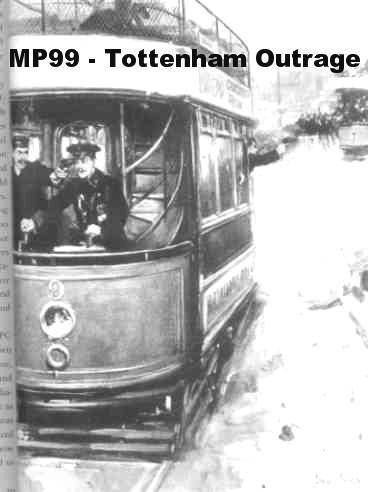
Helfeld and Lepidus both headed towards a railway foot-bridge at the end of Down Road leading to Tottenham Marshes. In an attempt to cut them off, Constables Tyler and Newman ran across waste ground, out of sight of the armed offenders and protected by a high fence, and ended up with Tyler coming face-to-face with Helfeld and Lepidus as they ran out from the other side of the fence. Constable Tyler shouted "Come on, give in, the game's up." Helfeld took careful aim and shot Tyler through the head. Constable Newman stayed with Tyler and helped move him to a nearby private house awaiting an ambulance. Five minutes after being admitted to hospital, Tyler was pronounced dead.
By this time, officers from all nearby stations were converging on Tottenham Marshes, some armed and others not. Lepidus and Helfeld had been forced to turn north-east, which led them to the River Lea. While they were searching for a crossing place, a number of civilian bystanders joined in the chase but were wounded. The would-be robbers crossed the river, and on arriving at Mill Stream Bridge, they rested and fired more shots at their civilian pursuers, injuring two more. Constable Nicod arrived on the scene unobserved by the two. He crawled forward with a revolver, which failed to fire. He was noticed by Helfeld and Lepidus, leading to his being shot in the left thigh and leg. The two continued to be chased along the south side of the Banbury Reservoir in Walthamstow, before being confronted by Sidney Slater, a horse keeper, who was fired at several times and disabled.
Constable Spedding also caught up and fired four shots from a borrowed revolver at the fleeing Lepidus and Helfeld, but all missed. Helfeld and Lepidus crossed a traveller encampment firing at several people, but caused no injuries. At Salisbury Farm the two rested, still pursued by civilians and police, and here William Roker was shot in the legs by Lepidus. The farmyard abutted Chingford Road, along which the Walthamstow Urban District Council trams ran. Helfeld and Lepidus hijacked a tram en route for Leyton. Several members of the public escaped the tram, but while on board Edward Loveday was shot in the throat. The police commandeered another tram, and it was boarded by about 40 officers. Further along the road, the tram containing Helfeld and Lepidus was in danger of being overtaken by a horse-drawn carriage driven by Constable Hawkins, who attempted to shoot at the tram, but crashed after Helfeld shot the horse.
After Helfeld and Lepidus were alerted that a police station was situated around the next corner, they both jumped off the tram and stole a milk cart, shooting its driver, George Conyard, in the chest and arm as he attempted to stop them. They drove the cart along Farnham Road into Forest Road, where it crashed while negotiating a bend. Abandoning the milk cart, Helfeld and Lepidus hijacked another horse and cart, with Lepidus riding the animal and Helfeld firing into the large crowd of people in pursuit, made up of a number of police and civilians, some armed, and some on foot while others were mounted or driving cars. The pursuing crowd was led by a motor car containing Constables Shakespeare and Gibbs, driven by Frederick Williams and also carrying Thomas Brown armed with a double-barreled shotgun who was exchanging fire with Helfeld and Lepidus. Sergeant Howitt and Constable Francis were on duty at Hagger Bridge, where, hearing shots and police whistles, they attempted to stop the horse and cart but retreated to cover after being fired upon several times. However, the officers caused the horse and cart to swerve and crash into Fulbourne Road and then into Wadham Road.
After abandoning the horse and cart, Helfeld and Lepidus fled to the River Ching and Lepidus climbed over a six-foot fence, leaving Helfeld behind. As the crowd neared Helfeld's position, he shot himself in the right eye, but survived the initial injury and was taken to the Prince of Wales Hospital. Constable Ziething caught up with Lepidus, and was fired at several times by the fugitive, but the bullets passed through his clothing and into a civilian, Frederick Mortimer. Lepidus ran into Hale End Road and was hidden from sight by a row of cottages. The end cottage was occupied by a family, Charles Rolstone, who was at work in the scullery with his wife and two children inside. Rolstone's wife saw Lepidus inside and fled the house, leaving Constable Dewhurst and Charles Shaffer, a baker, to rescue the children inside. Lepidus now appeared at one of the front bedroom windows and was driven back by a hail of gunfire from the mixture of police and civilians outside. Constable Eagles armed himself with a borrowed civilian pistol, climbed a ladder placed at the back of the cottage and opened a bedroom window. At the same time at the front of the house, Constables Cater and Dixon, both armed with service revolvers, broke in through a ground-floor window, with a dog also being released into the house in the hope it would flush Lepidus out. While looking through the window, Constable Eagles saw Lepidus point his firearm directly at him, but the officer could not operate his borrowed weapon's faulty safety catch. Eagles climbed back down to the ground and was joined by Constables Dixon and Cater and Inspector Gould, who were all armed.
After storming the house, Eagles fired twice and Cater once through the door into the room where Lepidus was. This was followed by a shot from inside. The officers burst into the room and found Lepidus dead. Autopsy results would reveal that the calibre which killed the anarchist did not match either Cater's or Eagles's firearms, and that Lepidus had killed himself. The site of this final scene of the incident was near the Royal Oak public house in Hale End, Walthamstow.
Aftermath
The incident lasted more than two hours, covered a distance of six miles with an estimated 400 rounds fired by Helfeld and Lepidus. Twenty-five casualties were reported, two fatal (Constable Tyler and Ralph Joscelyne) and several serious. Tyler was publicly buried on 29 January in Abney Park Cemetery. Helfeld survived until 12 February in hospital and died following an operation. While in hospital, many officers were assigned to provide armed guarding to the building night and day, as a rescue attempt was deemed possible.
Many members of the public involved claimed for compensation for a variety of reasons, and some were later proved to be fraudulent. In recognition of their bravery, Constables Eagles, Dixon, Cater, Dewhurst, and Nicod were all promoted to Sergeant without examination. Constables Newman and Zeithing were advanced to the highest pay grade for their rank, without having completed the standard time allowing such.
Inspector Gould, Sergeant Hale, Constables Spedding, Bond and three others, all of whom had been active during the pursuit, were awarded from the Bow Street Court Reward Fund. Eagles, Cater and Dixon also went on to be awarded the King's Police Medal when the decoration was instituted in 1909. Ralph Joscelyne's mother kept the shoes her son had been wearing on the day he was killed. Following her wishes, they were buried with her when she died nearly 50 years later.
A collection was organised for PC Tyler's widow, raising £1,055. Joscelyne and Tyler were buried a yard apart at Abney Park Cemetery on Friday 29 January 1909, attended by Sir Edward Henry, the Commissioner of Police, and Herbert Samuel, Under-Secretary of State for the Home Department. The funeral cortège passed along a 2.5 mile route lined by 3,000 police officers and an estimated crowd of 500,000. The lengthy procession included white-plumed horses drawing Joscelyne's coffin and black-plumed horses drawing Tyler's coffin, draped in a Union Flag, which were escorted by hundreds of policemen (mounted and on foot), a police band, men from the local fire brigade, men from the Scots Guards and Royal Garrison Artillery, and tramway employees. A volley of guns was fired at the conclusion of the funeral.
A new medal, the King's Police Medal, was created to recognise the bravery of the police officers that had pursued the armed criminals. It was established by a Royal Warrant dated 7 July 1909, and three officers who broke into Oak Cottage to apprehend Lepidus were among the first recipients announced on 9 November 1909. Posthumous awards were not made until later, so Tyler went unrewarded.
The events were commemorated in a silent film, a book published in 2000 by Janet Dorothy Harris, Outrage! An Edwardian Tragedy. and a plaque commemorating Ralph's death on the Church of the Good Shepherd, Mitchley Road. A fact-based, but highly fictionalised re-imagining of the events of January 1909 forms a sub-plot of the 2014 crime thriller The Tottenham Outrage (ISBN 978-1-908699-67-1) by M. H. Baylis.
